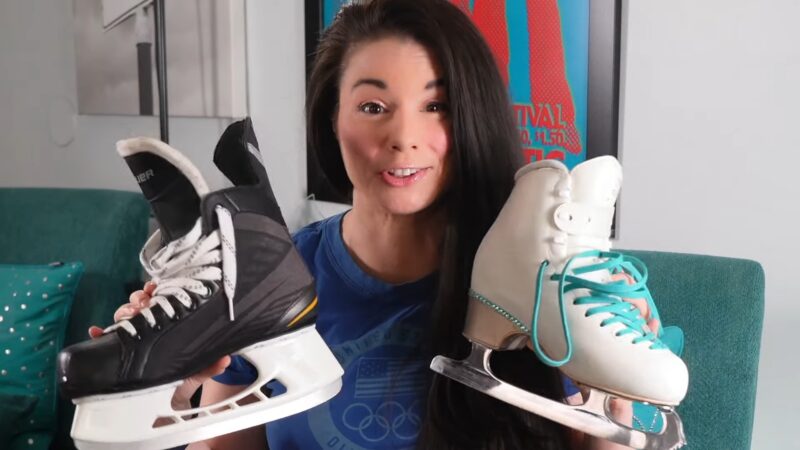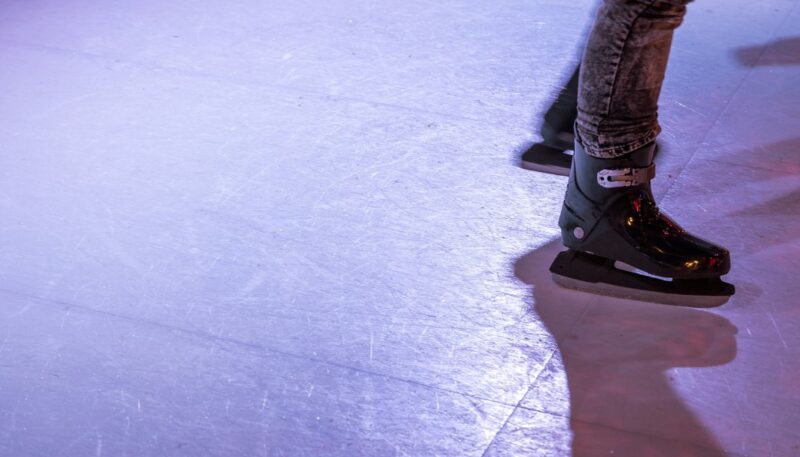
Before deciding that you want to construct a synthetic ice rink, it’s essential to understand what synthetic ice is and how it works. Synthetic ice panels are engineered to replicate the feel of real ice.
These panels are typically interlocking, making them easy to assemble and disassemble.
The surface allows for the use of regular ice skates, and while the glide is not identical to real ice, recent advancements have significantly improved the skating experience on synthetic ice.

Choosing the Right Location

Selecting an appropriate location for your rink is crucial. It should be a flat, level surface that can support the weight of the synthetic ice panels and the skaters.
Common locations include garages, basements, backyards, or any spacious area that can accommodate the size of your desired rink.
Consider the environment as well; outdoor setups should be in a space that’s sheltered from excessive sun, wind, and precipitation.
Sizing Your Rink
The size depends on your available space and your skating needs. A small one for casual skating or practice can be as modest as 20×40 feet.
If you plan to play games like hockey or host multiple skaters, you might want to opt for a larger size.
Ensure that the chosen area allows for extra room for safety and accessibility.
Purchasing Quality Synthetic Ice

Investing in high-quality synthetic ice is essential for a good skating experience. Look for panels that offer UV protection, especially if the rink will be outdoors.
The best panels have self-lubricating properties, reducing the need for additional glide enhancers.
Thickness and density also play a role in durability and skating quality. Research and read reviews to find the most recommended brands.
Preparing the Base
The base for your synthetic ice rink needs to be firm, level, and smooth. For outdoor setups, you might need to level the ground and add a layer of compacted sand or gravel.
Indoors, ensure that the floor is even and can bear the weight of the rink.
Adding a vapor barrier under the panels can prevent moisture damage, especially in outdoor setups.
Assembling

Assembling a synthetic ice rink involves a straightforward process, primarily due to the interlocking design of the panels, which resemble puzzle pieces for easy installation.
Here are some insights based on the information and related resources:
- It’s crucial to adhere to the guidelines provided by the manufacturer to ensure proper installation and optimal performance of the synthetic ice surface.
- The panels are designed to fit together like puzzle pieces, which simplifies the installation process and helps create a uniform skating surface.
- Ensuring that all panels are securely connected and the surface is level is essential for the safety of skaters and the longevity of the rink.
Considerations for Installation:
- Decide whether the rink will be installed indoors or outdoors, as this may influence the type of panels you choose.
- Plan the size and shape of your rink to ensure you have the appropriate number and type of panels.
- Consider the maintenance requirements, including cleaning and occasional surface treatments, to keep the rink in optimal condition.
Maintenance
Maintaining a synthetic ice rink is crucial for ensuring its longevity, performance, and the safety of skaters.
The process is straightforward, cost-effective, and does not require extensive maintenance, making synthetic ice a low-maintenance option for both home and commercial owners.
Here are the best practices for maintaining your synthetic ice rink:
| Maintenance Aspect | Details |
|---|---|
| Regular Cleaning | Essential to keep the surface smooth and free of debris. Use a large, soft-cloth push-broom or a shop vac/leaf blower for dust and dirt. |
| Periodic Inspection | Regularly check the panels for wear or damage to maintain a quality skating experience. |
| Proper Use and Care | Use the ice for skating only. Keep skates clean and sharp. |
| Storage | Cover the tiles with a tarp or blanket when not in use, especially if stored outdoors, to protect against dust and dirt build-up. |
| Maintenance Tools | Keep maintenance tools like brooms, vacuums, and mops near the rink. Clean the rink before and after each use to maintain its condition. |
Safety Considerations
Safety is paramount when enjoying your home ice rink. Always wear appropriate skating gear, including helmets, especially for children or less experienced skaters.
Ensure that the rink’s surface is free from obstacles, and consider adding padding around the perimeter for added safety.
Customization

One of the joys of having a home ice skating rink is the ability to customize it to your preferences. You can choose the shape of the rink, add personal touches like decals or markings, and even create zones for different activities.
For instance, you might want to designate a specific area for practicing hockey drills or figure skating moves. If space allows, you could even incorporate a small seating area for spectators or resting skaters.
Utilizing Rink Accessories
To enhance your skating experience, consider incorporating various accessories. Goals and nets are perfect for hockey practice, while a small Zamboni-like resurfacer can keep the surface smooth. Training aids such as cones and markers are great for skill development.
Storage solutions for skates and equipment can keep your rink area organized and efficient.
Weatherproofing

If your rink is outdoors, weatherproofing is crucial. Synthetic ice is designed to withstand various weather conditions, but additional measures can extend its lifespan.
Consider using covers to protect the rink from debris and harsh weather when not in use.
Proper drainage around the area will prevent water accumulation, which can affect the base and the panels.
Energy Efficiency and Eco-Friendliness
Synthetic ice offers an eco-friendlier alternative to traditional ice rinks, as it doesn’t require refrigeration or large amounts of water. To further enhance its sustainability, consider using energy-efficient lighting for night skating.
If possible, integrate renewable energy sources like solar panels to power lights or other electrical components of your rink.
Budgeting and Cost Management

Creating a synthetic ice rink can be a significant investment. It’s important to budget carefully, considering not just the initial cost of the panels, but also accessories, maintenance equipment, and potential upgrades.
Look for ways to maximize your investment, such as buying quality materials that will last longer and require less maintenance.
Initial Investment
The cost of synthetic ice rinks varies significantly based on size, thickness of the panels, and quality of materials. High-quality, durable polyethylene (HDPE or UHMWPE) is typically used, offering a smooth and low-friction surface.
The initial investment includes not only the surface material but also panels or tiles, which can range in price depending on their size and thickness.
Quality vs. Cost
Investing in higher-quality materials may have a higher upfront cost but can lead to savings in the long run due to lower maintenance requirements and longer lifespan. For example, a box of 4 – 24″ x 48″ tiles might cost around $289.95, while larger, commercial-grade sheets could be priced at $389.95 each plus shipping.
Additional Components
Costs also include dasher boards, edging, and netting for hockey rinks, which vary based on the size and the materials used. These components are essential for a functional rink but add to the overall investment.
The Bottom Line
Building a synthetic ice rink at home is a multifaceted project that combines fun, physical activity, and the opportunity to engage with family, friends, and even your local community.
If you consider location, materials, and design, and by emphasizing safety, maintenance, and legal aspects, you can create a wonderful ice skating haven right in your backyard or home.












